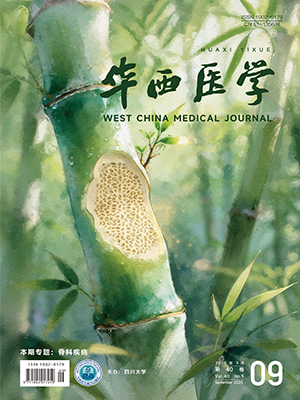| 1. |
中華護理學會靜脈輸液治療專業委員會. 靜脈導管常見并發癥臨床護理實踐指南. 中華現代護理雜志, 2022, 28(18): 2381-2395.
|
| 2. |
O’Grady NP, Alexander M, Dellinger EP, et al. Guidelines for the prevention of intravascular catheter-related infections. Infect Control Hosp Epidemiol, 2002, 23(12): 759-769.
|
| 3. |
Barrigah-Benissan K, Ory J, Simon C, et al. Clinical factors associated with peripherally inserted central catheters (PICC) related bloodstream infections: a single centre retrospective cohort. Antimicrob Resist Infect Control, 2023, 12(1): 5.
|
| 4. |
Durand GA, Abat C, Cassir N, et al. Peripherally inserted central catheters: a hidden emerging cause of infection outbreaks. New Microbes New Infect, 2020, 35: 100671.
|
| 5. |
王春立, 吳思婷, 吳心怡, 等. 經外周置入中心靜脈導管相關血流感染預防的最佳證據總結. 中華現代護理雜志, 2022, 28(31): 4324-4330.
|
| 6. |
Saegeman V, Cossey V, Schuermans A. Reducing central-line-associated bloodstream infections by half: it is possible. J Hosp Infect, 2022, 128: 89-91.
|
| 7. |
Herc E, Patel P, Washer LL, et al. A model to predict central-line-associated bloodstream infection among patients with peripherally inserted central catheters: the MPC score. Infect Control Hosp Epidemiol, 2017, 38(10): 1155-1166.
|
| 8. |
Sakai H, Iwata M, Terasawa T. External validation of the Michigan PICC catheter-associated bloodstream infections score (MPC score) for predicting the risk of peripherally inserted central catheter-associated bloodstream infections: a single-center study in Japan. Infect Control Hosp Epidemiol, 2023, 44(3): 480-483.
|
| 9. |
陶雍, 毛靜玉, 薛嵋, 等. 腫瘤患者PICC導管相關血流感染風險預測模型的構建. 中國護理管理, 2022, 22(11): 1718-1721.
|
| 10. |
唐倩蕓, 邢柏. 預測PICC導管相關血流感染風險的列線圖模型的建立與驗證. 中國醫藥導報, 2020, 17(36): 45-48.
|
| 11. |
吉史伍呷, 方進博. 機器學習在心力衰竭病人預后評估中的應用研究進展. 護理研究, 2023, 37(7): 1195-1199.
|
| 12. |
Centers for Disease Control and Prevention. Updated recommendations on the use of chlorhexidine-impregnated dressings for prevention of intravascular catheter-related infections (2017). Georgia: Centers for Disease Control and Prevention, 2017: 1-15.
|
| 13. |
O’Grady NP, Alexander M, Dellinger EP, et al. Guidelines for the prevention of intravascular catheter-related infections. The Hospital Infection Control Practices Advisory Committee, Center for Disease Control and Prevention, U. S. Pediatrics, 2002, 110(5): e51.
|
| 14. |
Gorski LA, Hadaway L, Hagle ME, et al. Infusion therapy standards of practice, 8th edition. J Infus Nurs, 2021, 44(Suppl 1): S1-S224.
|
| 15. |
Ling ML, Apisarnthanarak A, Jaggi N, et al. APSIC guide for prevention of Central Line Associated Bloodstream Infections (CLABSI). Antimicrob Resist Infect Control, 2016, 5: 16.
|
| 16. |
蔡虻, 王霞, 孫超, 等. 導管相關感染防控最佳護理實踐: 從常規到循證. 中華現代護理雜志, 2020, 26(13): 1681-1687.
|
| 17. |
Buetti N, Marschall J, Drees M, et al. Strategies to prevent central line-associated bloodstream infections in acute-care hospitals: 2022 update. Infect Control Hosp Epidemiol, 2022, 43(5): 553-569.
|
| 18. |
Buetti N, Ruckly S, Schwebel C, et al. Chlorhexidine-impregnated sponge versus chlorhexidine gel dressing for short-term intravascular catheters: which one is better? Crit Care, 2020, 24(1): 458.
|
| 19. |
Timsit JF, Schwebel C, Bouadma L, et al. Chlorhexidine-impregnated sponges and less frequent dressing changes for prevention of catheter-related infections in critically ill adults: a randomized controlled trial. JAMA, 2009, 301(12): 1231-1241.
|
| 20. |
Eggimann P, Pagani JL, Dupuis-Lozeron E, et al. Sustained reduction of catheter-associated bloodstream infections with enhancement of catheter bundle by chlorhexidine dressings over 11 years. Intensive Care Med, 2019, 45(6): 823-833.
|
| 21. |
Puig-Asensio M, Marra AR, Childs CA, et al. Effectiveness of chlorhexidine dressings to prevent catheter-related bloodstream infections. Does one size fit all? A systematic literature review and meta-analysis. Infect Control Hosp Epidemiol, 2020, 41(12): 1388-1395.
|
| 22. |
Frost SA, Alogso MC, Metcalfe L, et al. Chlorhexidine bathing and health care-associated infections among adult intensive care patients: a systematic review and meta-analysis. Crit Care, 2016, 20(1): 379.
|
| 23. |
Mimoz O, Lucet JC, Kerforne T, et al. Skin antisepsis with chlorhexidine-alcohol versus povidone iodine-alcohol, with and without skin scrubbing, for prevention of intravascular-catheter-related infection (CLEAN): an open-label, multicentre, randomised, controlled, two-by-two factorial trial. Lancet, 2015, 386(10008): 2069-2077.
|
| 24. |
Huang SS, Septimus E, Kleinman K, et al. Chlorhexidine versus routine bathing to prevent multidrug-resistant organisms and all-cause bloodstream infections in general medical and surgical units (ABATE Infection trial): a cluster-randomised trial. Lancet, 2019, 393(10177): 1205-1215.
|
| 25. |
Wang H, Tong H, Liu H, et al. Effectiveness of antimicrobial-coated central venous catheters for preventing catheter-related blood-stream infections with the implementation of bundles: a systematic review and network meta-analysis. Ann Intensive Care, 2018, 8(1): 71.
|
| 26. |
Kramer RD, Rogers MA, Conte M, et al. Are antimicrobial peripherally inserted central catheters associated with reduction in central line-associated bloodstream infection? A systematic review and meta-analysis. Am J Infect Control, 2017, 45(2): 108-114.
|
| 27. |
Selby LM, Rupp ME, Cawcutt KA. Prevention of central-line associated bloodstream infections: 2021 update. Infect Dis Clin North Am, 2021, 35(4): 841-856.
|
| 28. |
Hymes JL, Mooney A, Van Zandt C, et al. Dialysis catheter-related bloodstream infections: a cluster-randomized trial of the ClearGuard HD antimicrobial barrier cap. Am J Kidney Dis, 2017, 69(2): 220-227.
|
| 29. |
Tejada S, Leal-Dos-Santos M, Pe?a-López Y, et al. Antiseptic barrier caps in central line-associated bloodstream infections: a systematic review and meta-analysis. Eur J Intern Med, 2022, 99: 70-81.
|
| 30. |
Brunelli SM, Van Wyck DB, Njord L, et al. Cluster-randomized trial of devices to prevent catheter-related bloodstream infection. J Am Soc Nephrol, 2018, 29(4): 1336-1343.
|
| 31. |
Zacharioudakis IM, Zervou FN, Arvanitis M, et al. Antimicrobial lock solutions as a method to prevent central line-associated bloodstream infections: a meta-analysis of randomized controlled trials. Clin Infect Dis, 2014, 59(12): 1741-1749.
|
| 32. |
Scrivens N, Sabri E, Bredeson C, et al. Comparison of complication rates and incidences associated with different peripherally inserted central catheters (PICC) in patients with hematological malignancies: a retrospective cohort study. Leuk Lymphoma, 2020, 61(1): 156-164.
|
| 33. |
中國抗癌協會腫瘤護理專業委員會. 隧道式經外周靜脈置入中心靜脈導管置管技術專家共識(2022). 中華現代護理雜志, 2023, 29(9): 1121-1129.
|
| 34. |
Kim IJ, Shim DJ, Lee JH, et al. Impact of subcutaneous tunnels on peripherally inserted catheter placement: a multicenter retrospective study. Eur Radiol, 2019, 29(5): 2716-2723.
|
| 35. |
Lee JH, Kim ET, Shim DJ, et al. Prevalence and predictors of peripherally inserted central catheter-associated bloodstream infections in adults: a multicenter cohort study. PLoS One, 2019, 14(3): e0213555.
|
| 36. |
Lee JH, Kim MU, Kim ET, et al. Prevalence and predictors of peripherally inserted central venous catheter associated bloodstream infections in cancer patients: a multicentre cohort study. Medicine (Baltimore), 2020, 99(6): e19056.
|
| 37. |
Lafuente Cabrero E, Terradas Robledo R, Civit Cu?ado A, et al. Risk factors of catheter- associated bloodstream infection: systematic review and meta-analysis. PLoS One, 2023, 18(3): e0282290.
|
| 38. |
王琴, 鄭嘉祺, 陳金, 等. 腫瘤患者PICC導管相關感染危險因素的Logistic回歸分析. 中國消毒學雜志, 2020, 37(8): 604-607.
|
| 39. |
張鳴璐, 劉麗麗, 朱麗娜. 為留置PICC的患者用不同敷料對其醫用黏膠相關性皮膚損傷發生及改善情況的影響. 當代醫藥論叢, 2020, 18(4): 38-41.
|
| 40. |
許麗莎, 謝素友, 施燕選. 個體化健康教育對乳腺癌PICC置管患者自我管理水平及導管留置時間的影響. 醫學食療與健康, 2021, 19(8): 158-159.
|
| 41. |
范祖燕, 林金香, 吳丹純. 微信在攜帶PICC管出院腫瘤病人延續性護理中的應用. 護理研究, 2016, 30(26): 3283-3285.
|
| 42. |
Gastmeier P, Geffers C, Brandt C, et al. Effectiveness of a nationwide nosocomial infection surveillance system for reducing nosocomial infections. J Hosp Infect, 2006, 64(1): 16-22.
|
| 43. |
Hansen S, Schwab F, Behnke M, et al. National influences on catheter-associated bloodstream infection rates: practices among national surveillance networks participating in the European HELICS project. J Hosp Infect, 2009, 71(1): 66-73.
|
| 44. |
Badia-Cebada L, Pe?afiel J, Saliba P, et al. Trends in the epidemiology of catheter-related bloodstream infections; towards a paradigm shift, Spain, 2007 to 2019. Euro Surveill, 2022, 27(19): 2100610.
|
| 45. |
尚文涵, 李長安, 吳志軍, 等. 國家護理質量數據平臺的建設、應用及改進建議. 中國衛生質量管理, 2019, 26(3): 前插1, 1-4.
|
| 46. |
Verberk JDM, Aghdassi SJS, Abbas M, et al. Automated surveillance systems for healthcare-associated infections: results from a European survey and experiences from real-life utilization. J Hosp Infect, 2022, 122: 35-43.
|
| 47. |
Lin MY, Hota B, Khan YM, et al. Quality of traditional surveillance for public reporting of nosocomial bloodstream infection rates. JAMA, 2010, 304(18): 2035-2041.
|
| 48. |
Januel JM, Lotfinejad N, Grant R, et al. Predictive performance of automated surveillance algorithms for intravascular catheter bloodstream infections: a systematic review and meta-analysis. Antimicrob Resist Infect Control, 2023, 12(1): 87.
|
| 49. |
Bessis S, Cassir N, Meddeb L, et al. Early mortality attributable to PICC-lines in 4 public hospitals of Marseille from 2010 to 2016 (revised V3). Medicine (Baltimore), 2020, 99(1): e18494.
|
| 50. |
Musu M, Finco G, Mura P, et al. Controlling catheter-related bloodstream infections through a multi-centre educational programme for intensive care units. J Hosp Infect, 2017, 97(3): 275-281.
|
| 51. |
劉美華, 彭劍雄, 仇君, 等. 查檢單在PICU中心靜脈置管相關性血流感染防控中的應用. 當代護士(中旬刊), 2018, 25(2): 107-110.
|
| 52. |
尚文涵, 張海燕, 吳志軍, 等. 以護理質量控制指標為指引促進醫院感染管理持續改進. 中國護理管理, 2021, 21(4): 484-487.
|




